The Marvelous Malamute
This may be the closest thing to having a real wolf in your family - the gorgeous Alaskan Malamute! Chances are that you chose her because you like Mals and you expected her to have certain traits that would fit your lifestyle:
- An affectionate companion and family dog
- Outgoing and friendly personality
- Good with children
- Playful and energetic
- Loyal and loving companion
- Large, strong, and athletic, with lots of stamina in cooler climates
Some things you may also notice:
- Needs a lot of activity and mental stimulation to avoid boredom vices
- Early obedience training and socialization is recommended
- Needs to be brushed regularly to keep coat mat-free
- Likes to dig
- Sees cats and small animals as prey unless trained otherwise
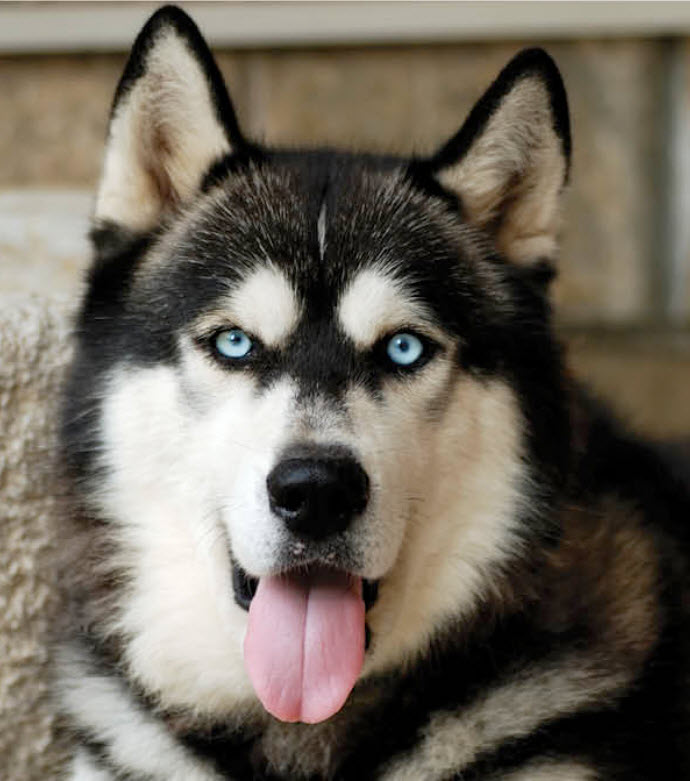 She loves her daily exercise, but also enjoys just hanging out with her family. Mals are very vocal and may howl, but they don’t bark a lot.
She loves her daily exercise, but also enjoys just hanging out with her family. Mals are very vocal and may howl, but they don’t bark a lot.
Alaskan Malamutes are the largest and oldest of the Arctic Sled dogs. Originating over 4000 years ago, Mals were kept by the Mahlemuts, an Inuit Tribe in Alaska. They are known for their stamina, not their speed, when pulling heavy sled loads. Alaskan Malamutes are a relatively healthy breed with an average lifespan of 12 years.
Your Alaskan Malamute's Health
We know that because you care so much about your dog, you want to take good care of her. That is why we have summarized the health concerns we will be discussing with you over the life of your Malamute. By knowing about health concerns specific to Alaskan Malamutes, we can tailor a preventive health plan to watch for and hopefully prevent some predictable risks.
Many diseases and health conditions are genetic, meaning they are related to your pet’s breed. There is a general consensus among canine genetic researchers and veterinary practitioners that the conditions described herein have a significant rate of incidence and/or impact in this breed. That does not mean your dog will have these problems; it just means that she is more at risk than other dogs. We will describe the most common issues seen in Alaskan Malamutes to give you an idea of what may come up in her future. Of course, we can’t cover every possibility here, so always check with us if you notice any unusual signs or symptoms.
This guide contains general health information important to all canines as well as the most important genetic predispositions for Alaskan Malamutes. This information helps you and us together plan for your pet’s unique medical needs. At the end of the article, we have also included a description of what you can do at home to keep your Mal looking and feeling her best. You will know what to watch for, and we will all feel better knowing that we’re taking the best possible care of your pal.
General Health Information for your Alaskan Malamute
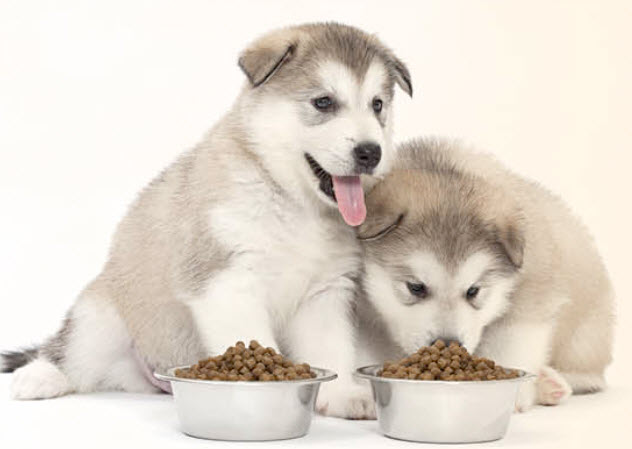 Dental Disease
Dental Disease
Dental disease is the most common chronic problem in pets, affecting 80% of all dogs by age two. And unfortunately, your Alaskan Malamute is more likely than other dogs to have problems with her teeth. It starts with tartar build-up on the teeth and progresses to infection of the gums and roots of the teeth. If we don’t prevent or treat dental disease, your buddy will lose her teeth and be in danger of damaging her kidneys, liver, heart, and joints. In fact, your Alaskan Malamute's lifespan may be cut short by one to three years! We’ll clean your dog’s teeth regularly and let you know what you can do at home to keep those pearly whites clean.
Infections
Alaskan Malamutes are susceptible to bacterial and viral infections — the same ones that all dogs can get — such as parvo, rabies, and distemper. Many of these infections are preventable through vaccination, which we will recommend based on the diseases we see in our area, her age, and other factors.
Obesity
Obesity can be a significant health problem in Alaskan Malamutes. It is a serious disease that may cause or worsen joint problems, metabolic and digestive disorders, back pain and heart disease. Though it’s tempting to give your pal food when she looks at you with those soulful eyes, you can “love her to death” with leftover people food and doggie treats. Instead, give her a hug, brush her fur or teeth, play a game with her, or perhaps take her for a walk. She’ll feel better, and so will you!
Parasites
All kinds of worms and bugs can invade your Mal's body, inside and out. Everything from fleas and ticks to ear mites can infest her skin and ears. Hookworms, roundworms, heartworms, and whipworms can get into her system in a number of ways: drinking unclean water, walking on contaminated soil, or being bitten by an infected mosquito. Some of these parasites can be transmitted to you or a family member and are a serious concern for everyone. For your canine friend, these parasites can cause pain, discomfort, and even death, so it’s important that we test for them on a regular basis. Your Georgia Veterinary Associates medical team will also recommend preventive medication as necessary to keep her healthy.
Spay or Neuter
One of the best things you can do for your Malamute is to have her spayed (neutered for males). In females, this means we surgically remove the ovaries and usually the uterus, and in males, it means we surgically remove the testicles. Spaying or neutering decreases the likelihood of certain types of cancers and eliminates the possibility of your pet becoming pregnant or fathering unwanted puppies. Performing this surgery also gives us a chance, while your pet is under anesthesia, to identify and address some of the diseases your dog is likely to develop. For example, if your pet needs hip X-rays or a puppy tooth extracted, this would be a good time. This is convenient for you and easy for your friend. Routine blood testing prior to surgery also helps us to identify and take precautions for common problems that increase anesthetic or surgical risk. Don’t worry; we’ll discuss the specific problems we will be looking for when the time arrives.
Genetic Predispositions for Alaskan Malamutes
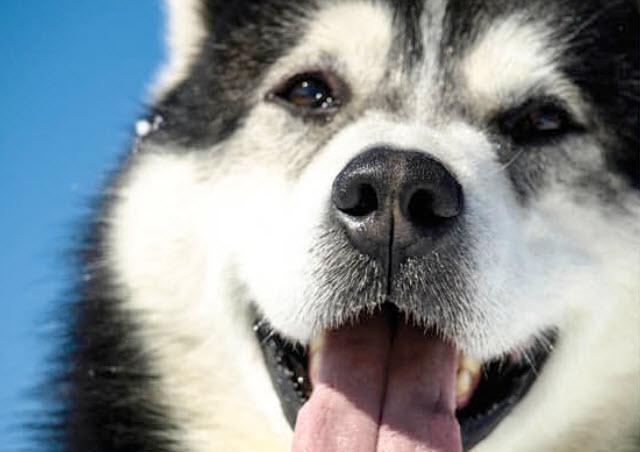 Hip Dysplasia
Hip Dysplasia
You’ve probably heard of hip dysplasia, an inherited disease that causes the hip joints to form improperly and leads to arthritis: it is common in Alaskan Malamutes. You may notice that he has lameness in his hind legs or has difficulty getting up from lying down. We can treat the arthritis — the sooner the better — to avoid discomfort and pain. We’ll take X-rays of your dog’s joints to identify the disease as early as possible. Surgery is sometimes considered in severe and life-limiting cases of hip dysplasia. Keep in mind that overweight dogs may develop arthritis years earlier than those of normal weight, causing undue pain and suffering.
Dwarfism
Normally, as a puppy grows, he first builds the form of his bones in cartilage, then fills it in with bone later. Sometimes this process goes wrong, and there is an abnormal growth of cartilage and bone in early development. Some dwarf breeds, like the Dachshund or Basset Hound, have been selectively bred to have this condition. When it occurs in your Malamute, though, it is considered abnormal. There is no treatment for the condition, which is not painful, it just means that the dog will have shorter legs than normal. The trait is inherited, so responsible breeders recommend not using affected individuals for breeding.
Bloat
Gastric Dilatation and Volvulus, also known as GDV or Bloat, usually occurs in dogs with deep, narrow chests. This means your Malamute is more at risk than other breeds. When a dog bloats, the stomach twists on itself and fills with gas. The twisting cuts off blood supply to the stomach, and sometimes the spleen. Left untreated, the disease is quickly fatal, sometimes in as little as 30 minutes. Your dog may retch or heave (but little or nothing comes out), act restless, have an enlarged abdomen, or lie in a prayer position (front feet down, rear end up). Preventive surgery in which the stomach is tacked down or sutured in place so that it is unlikely to twist is an option. If you see symptoms, take your pet to an emergency hospital immediately!
Peripheral Neuropathy
If your Alaskan Malamute is affected by this rare inherited disease of his nerves, he will have weakness, poor reflexes, loss of balance and a loud bark starting around 8 weeks of age. Since young puppies can appear a bit unsteady on their legs as it is, it is easy to miss the first signs of the condition. Instead of improving as the puppy grows, the condition often worsens, progressing to death within a few months. However, some dogs experience a partial reversal of the condition, which allows the dog to relearn how to walk. There is no proven treatment for this nerve disorder, although some alternative medical therapies may help. In addition, the right dog lover can greatly enhance these dogs' quality of life with the right assistive devices.
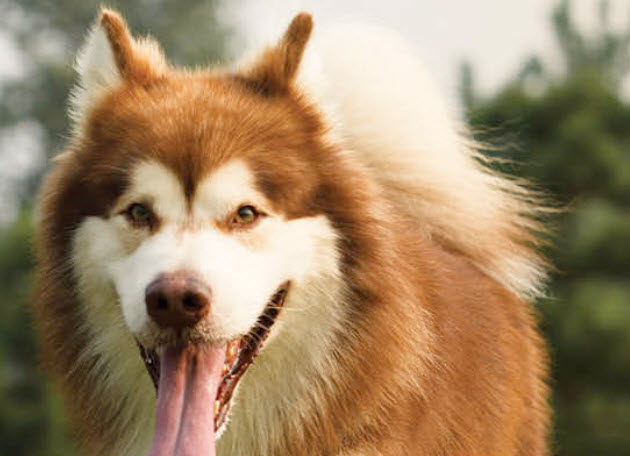 Thyroid Problems
Thyroid Problems
Malamutes are prone to a common condition called hypothyroidism in which the body doesn’t make enough thyroid hormone. Signs can include dry skin and coat, hair loss, susceptibility to other skin diseases, weight gain, fearfulness, aggression, or other behavioral changes. We’ll conduct a blood screening test annually to screen for the disease. Treatment is usually simple: replacement hormones given in the form of a pill.
Eye Problems
Not many things have as dramatic an impact on your dog's quality of life as the proper functioning of his eyes. Unfortunately, Alaskan Malamutes can inherit or develop a number of different eye conditions, some of which may cause blindness if not treated right away, and most of which can be extremely painful! We will evaluate his eyes at every examination to look for any signs of concern.
- Progressive Retinal Atrophy (PRA) is an inherited disease in which the eyes are genetically programmed to go blind. Unfortunately, Alaskan Malamutes are a bit more likely than other dogs to have this condition. PRA is not painful, but also not curable. In dogs with the bad gene, early symptoms such as night blindness or dilated pupils generally begin around three to five years of age. A genetic test is available for this condition.
- Cataracts are a common cause of blindness in older Malamutes. We’ll watch for the lenses of his eyes to become more opaque—meaning they look cloudy instead of clear—when we examine him. Many dogs adjust well to losing their vision and get along just fine. Surgery to remove cataracts and restore sight may also be an option.
Epilepsy
There are three types of seizures in dogs: reactive, secondary, and primary. Reactive seizures are caused by the brain's reaction to a metabolic problem like low blood sugar, organ failure, or a toxin. Secondary seizures are the result of a brain tumor, stroke, or trauma. If no other cause can be found, the disease is called primary, or idiopathic epilepsy. This problem is often an inherited condition, with Alaskan Malamutes commonly afflicted. If your friend is prone to seizures, they will usually begin between six months and three years of age. An initial diagnostic workup may help find the cause. Lifelong medication is usually necessary to help keep seizures under control, with periodic blood testing required to monitor side effects and effectiveness. If your dog has a seizure: Carefully prevent him from injuring himself, but don't try to control his mouth or tongue. It won't help him, and he may bite you accidentally! Note the length of the seizure, and call us at 678-407-0700 or an emergency hospital.
VKH Syndrome
This complex disease, found at higher incidence in Alaskan Malamutes, is also known as uveodermatologic syndrome: “uveo” referring to the inside of the eye and “derm” referring to the skin. This is an autoimmune disorder in which the immune system attacks the cells that make pigment in the skin and inside the eyes. It can cause pain or blindness inside the eye and the pigmented areas of his nose, lips, and skin to change from dark to light. Sunlight makes the condition worse.
Diabetes
Diabetes mellitus is a fairly common disease in dogs. Any breed can be affected, but Mals have an above average incidence. Dogs with diabetes are unable to regulate the metabolism of sugars and require daily insulin injections. It is a serious condition and one that is important to diagnose and treat as early as possible. Symptoms include increased eating, drinking, and urination, along with weight loss. If he shows signs, we will conduct lab tests to determine if he has this condition and discuss treatment options with you. Treatment requires a serious commitment of time and resources. Well regulated diabetic dogs today have the same life expectancy as other canines.
Cancer
Cancer is a leading cause of death in older dogs. Your Alaskan Malamute will likely live longer than many other breeds and therefore is more prone to get cancer in his golden years. Many cancers are curable by surgical removal, and some types are treatable with chemotherapy. Early detection is critical! We’ll perform periodic diagnostic tests and look for lumps and bumps when we examine your pet. The lifetime health care chart included in this guide will list the specific cancers that we will be monitoring for.
Alopecia X
Alopecia X or adrenal sex-hormone imbalance is known to causes patchy hair loss. It can also cause a fuzzy or woolly coat on each side of your friend’s body. Neutering often resolves the problem. This disease can sometimes be treated with the same medications that are used for Cushing’s disease, another disorder involving the adrenal glands. Alopecia X is more a cosmetic problem than a serious medical issue, but responsible Malamute breeders recommend not using affected individuals for breeding.
Skin Infections
Your Malamute is prone to a form of skin infection called zinc-responsive dermatosis, in which he either isn’t getting enough zinc in his diet or doesn’t absorb it properly. Signs include red, hairless, crusting, scaling, or oozing skin around the mouth, chin, eyes, and ears or lesions on the foot pads and nose. If your dog develops this disease, we’ll prescribe a carefully regulated amount of zinc in his diet.
Mange
Demodex is a microscopic mite that lives in the hair follicles of dogs. All dogs have them. Normally a dog’s immune system keeps the mites in check, but some breeds, like your Malamute, develop an overabundance of these mites. In mild cases, pet owners may notice a few dry, irritated, hairless lesions. These often occur on the face or feet and may or may not be itchy. Secondary skin infections may occur. Prompt veterinary care is important to keep the disease from getting out of hand. Many pets seem to outgrow the problem, while others require lifelong management.
Bleeding Disorders
Your Alaskan Malamute is prone to a bleeding disorder called hemophilia. We’ll conduct diagnostic testing to assess his blood clotting time before we perform surgery. This is an important test, as we may not know your pet has this disorder until severe bleeding occurs during surgery or after a serious injury.
Retained Puppy Teeth
Dogs normally begin to lose their primary ("puppy") teeth at around 4 months of age. When the primary teeth don't fall out as the adult teeth come in, infection or damage to the adult teeth may develop. Retained teeth are common in some breeds like Malamutes. The retained puppy teeth trap food and hair between the normal adult tooth and the primary tooth. Painful gums, bad breath and adult tooth loss can result if untreated. We'll monitor his growing teeth and recommend removal of the puppy teeth if they are present alongside his adult teeth.
Heart Disease
Alaskan Malamutes are prone to multiple types of heart disease, which can occur both early and later in life. We’ll listen for heart murmurs and abnormal heart rhythms when we examine your pet. When indicated, we’ll perform an annual heart health check, which may include X-rays, an ECG, or an echocardiogram, depending on your dog’s risk factors. Early detection of heart disease often allows us to treat with medication that usually prolongs your pet’s life for many years. Veterinary dental care and weight control go a long way in preventing heart disease.
Taking Care of Your Alaskan Malamute at Home
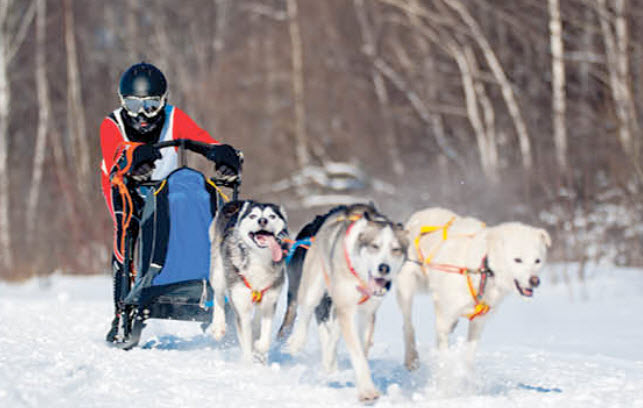 Much of what you can do to keep your dog happy and healthy is common sense, just like it is for people. Watch her diet, make sure she gets plenty of exercise, regularly brush her teeth and coat, and call us or a pet emergency hospital when something seems unusual (see “What to Watch For” below). Be sure to adhere to the schedule of examinations and vaccinations that we recommend for her. This is when we’ll give her the necessary “check-ups” and test for diseases and conditions that are common in Malamutes. Another very important step in caring for your pet is signing up for pet health insurance. There will certainly be medical tests and procedures she will need throughout her life and pet health insurance will help you cover those costs.
Much of what you can do to keep your dog happy and healthy is common sense, just like it is for people. Watch her diet, make sure she gets plenty of exercise, regularly brush her teeth and coat, and call us or a pet emergency hospital when something seems unusual (see “What to Watch For” below). Be sure to adhere to the schedule of examinations and vaccinations that we recommend for her. This is when we’ll give her the necessary “check-ups” and test for diseases and conditions that are common in Malamutes. Another very important step in caring for your pet is signing up for pet health insurance. There will certainly be medical tests and procedures she will need throughout her life and pet health insurance will help you cover those costs.
Routine Care, Diet, and Exercise
Build her routine care into your schedule to help your Mal live longer, stay healthier, and be happier during her lifetime. We cannot overemphasize the importance of a proper diet and exercise routine.
- Supervise your pet as you would a toddler. Keep doors closed, pick up after yourself, and block off rooms as necessary. This will keep her out of trouble and away from objects she shouldn’t put in her mouth.
- Brush her coat as needed, at least weekly.
- Alaskan Malamutes often have serious problems with their teeth, so you’ll need to brush them at least three times a week!
- Clean her ears weekly, even as a puppy. Don’t worry—we’ll show you how!
- She's a large dog with lots of energy, so keep her mind and body active, or she'll get bored. That's when the naughty stuff starts.
- Mals are expert diggers and climbers. It is recommended that you bury your fence and that it is at least 6 feet tall.
- Malamutes can be affected by snow nose, which is a loss of pigment from the nose, making her prone to sunburn. She will need dog-safe sunscreen.
- Keep your dog’s diet consistent and don’t give her people food.
- Feed a high-quality diet appropriate for her age.
- Exercise your dog regularly, but don’t overdo it at first.
What to Watch For
Any abnormal symptom could be a sign of serious disease, or it could just be a minor or temporary problem. The important thing is to be able to tell when to seek veterinary help, and how urgently. Many diseases cause dogs to have a characteristic combination of symptoms, which together can be a clear signal that your Alaskan Malamute needs help.
Office Calls
- Give us a call at 678-407-0700 for an appointment if you notice any of these types of signs:
- Change in appetite or water consumption
- Tartar build-up, bad breath, red gums, or broken teeth
- Itchy skin (scratching, chewing or licking), hair loss
- Lethargy, mental dullness, or excessive sleeping
- Fearfulness, aggression, or other behavioral changes
Emergencies
- Seek medical care immediately if you notice any of these types of signs:
- Scratching or shaking the head, tender ears, or ear discharge
- Inability or straining to urinate; discolored urine
- Cloudiness, redness, itching, or any other abnormality involving the eyes
- Leg stiffness, reluctance to rise, sit, use stairs, run, jump, or “bunny hopping”
- Dry heaving or a large, tight, painful abdomen
- Dull coat, hair loss, sluggish, weight gain
- Any abnormal shaking, trembling, or excessive involuntary tremors
- Increased hunger and thirst, weight loss
- Straining to defecate, bleeding, licking of the area around the rectum, or smelly discharge
- Dry, scaly, sometimes itchy hairless patches on face or paws
- Bruises easily or bleeds a lot from a small wound
- Coughing, exercise intolerance, rapid breathing at rest
